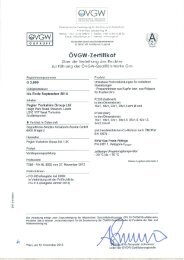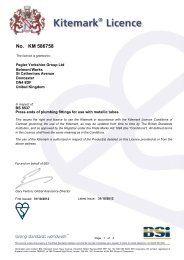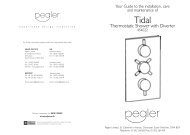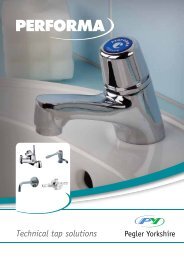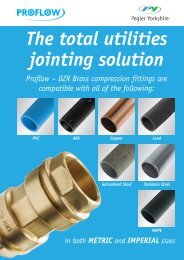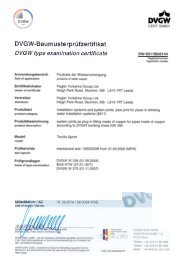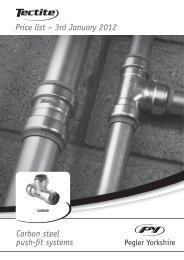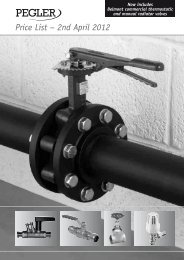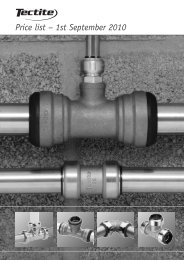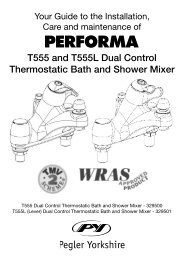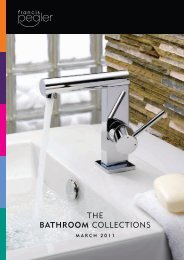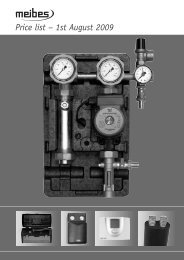Tectite Push Fit Solutions - Pegler Yorkshire
Tectite Push Fit Solutions - Pegler Yorkshire
Tectite Push Fit Solutions - Pegler Yorkshire
You also want an ePaper? Increase the reach of your titles
YUMPU automatically turns print PDFs into web optimized ePapers that Google loves.
3<br />
Phenolic foam<br />
When using rigid phenolic foam<br />
(or other thermal insulation) to<br />
lag pipework, always remember<br />
to refer to the lagging<br />
manufacturer’s fixing<br />
instructions. To avoid the risk<br />
of external corrosion of copper<br />
pipework lagged with this foam,<br />
it is recommended that such<br />
insulation products be installed<br />
with a moisture barrier.<br />
Materials like Densopaste or a<br />
plastics covering applied by the<br />
tube manufacturer both provide<br />
an appropriate barrier between<br />
the outer surface of the tube or<br />
fitting and the foam.<br />
Some manufacturers of this type<br />
of lagging supply their products<br />
with an internal, factoryapplied<br />
sodium silicate or<br />
polyethylene barrier to prevent<br />
external corrosion problems.<br />
However, if you do need to add<br />
a barrier product, we<br />
recommend that all <strong>Tectite</strong><br />
fittings are fully installed and<br />
pressure tested before these are<br />
applied and that they are<br />
completely coated.<br />
Covered pipework<br />
Making provision for thermal<br />
movement is vital where pipework<br />
of any material is installed<br />
under screed, plaster or passes<br />
through brick or blockwork.<br />
The preferred practice is to:<br />
pass tubes and pipes through<br />
sleeves or conduits or to lay<br />
them in ducts surrounded by<br />
loose, non-rigid material such<br />
as vermiculite or glass wool. For<br />
further information, consult the<br />
publication BS 6700:1997 Water<br />
Services in Buildings.<br />
Local Water Authority<br />
It’s wise to consult the local<br />
water authority when it comes<br />
to pipework accessibility.<br />
Tube bending<br />
Portable bending machines are<br />
ideal for copper tubes up to<br />
28mm. Most machines bend the<br />
tube between matched formers<br />
and back guides that support<br />
the outside diameter (OD) of<br />
the tube. This eliminates the<br />
risk of the tube wall collapsing.<br />
The point at which the bending<br />
pressure is exerted must be<br />
maintained at the correct<br />
distance in front of the former’s<br />
point of support. It’s also<br />
important to keep formers and<br />
guides well lubricated. Bending<br />
tubes correctly will avoid any<br />
wrinkling and flattening that<br />
can affect flow conditions.<br />
Using adjustable bending<br />
machines (which allow the<br />
pressure on the back guide to<br />
be adjusted) will ensure perfect<br />
bends every time so long as the<br />
root (inside) bending radius is<br />
at least 3 times the outside<br />
diameter of the tube.<br />
Pipework clearance<br />
When designing a <strong>Tectite</strong><br />
System, please take care to<br />
ensure all joints can be made<br />
and demounted easily. Observe<br />
minimum gaps and insertion<br />
distances to ensure sufficient<br />
access for a demounting<br />
clip/tool, where applicable<br />
(see fitting spacing tables).<br />
<strong>Fit</strong>ting spacing for<br />
<strong>Tectite</strong> Sprint and Advance<br />
(not demountable)<br />
Min. gap Min.<br />
between tube<br />
Sizes fittings projection<br />
10mm 5mm 20mm<br />
15mm 5mm 21mm<br />
22mm 5mm 23mm<br />
28mm 5mm 25mm<br />
<strong>Fit</strong>ting spacing for <strong>Tectite</strong><br />
Classic, Pro and 316<br />
Min. gap Min.<br />
between tube<br />
Sizes fittings projection<br />
10mm 10mm 40mm<br />
12mm 10mm 40mm<br />
15mm 10mm 40mm<br />
22mm 10mm 40mm<br />
28mm 10mm 50mm<br />
35mm 50mm 100mm<br />
42mm 50mm 100mm<br />
54mm 50mm 100mm<br />
Spacing<br />
<strong>Fit</strong>ting spacing<br />
Sufficient space must be left<br />
between fittings to allow<br />
room for dis-assembly tools to<br />
operate. See adjacent table<br />
for fitting spacing.<br />
Minimum projection<br />
Similar consideration should<br />
be given to the distance pipe<br />
stubs project through walls<br />
or bulkheads. Refer to table.<br />
Good practice<br />
Projection distances shown<br />
in the table also ensure that<br />
the subsequent installation<br />
will be a convenient distance<br />
from the wall.<br />
1 Range overview 2 Product details 3 Technical data 4 Installation instructions 57



